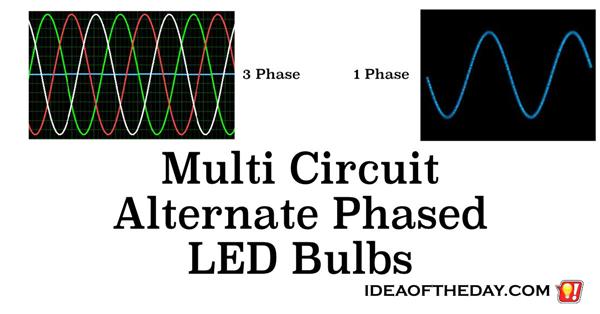Multi-Circuit Alternate Phased LED Bulbs

By
Staten Island, NY Posted: 12/23/2014 1:00:00 AM
This one is a bit technical, but stay with me. There's a reason.
Let me start by talking about how Edison's original light bulbs work. The concept is simple, a current is applied to a filament until it got so hot, that it glows. Once you turn off the current, the filament cools off, and the light goes off.
In the US, power cycles at 60 Hz, which means the power actually fluctuates on and off about 60 times per second.
With a fluctuation of just 1/60th of a second, the older incandescent bulbs still remain pretty consistent, because it doesn't give the filament time enough to cool off, but LEDs are more sensitive to those fluctuations so although the human eye may not notice it, an LED bulb is actually flickering light and dark 60 times a second.
If the human eye doesn't notice it... why does it matter?
Although the human eye doesn't notice it, digital cameras do. What makes matters worse is that many people shoot video at 60 frames per second, creating a situation where under certain conditions, the timing of the shutter goes out of phase with the light. When that happens, some of the frames capture the light when it's between cycles and the light is lower, creating a fluttering effect.
When there's a lot of light, the flutter is harder to see, but when you look closer, there is a distracting amount of noise in the shot. When the light is lower, those fluctuations are very visible, totally ruining the shot.
You can fix this problem by lowering the shutter speed to 30 for example, but that limits your camera's flexibility. You can also get bulbs that run at a higher frequency, but that also limits the shutter speeds you can use. The real solution is to create a bulb that can let you shoot at any shutter speed.
My idea is for an LED bulb that uses at least 2 or 3 distinct circuits, each at it's own phase, linked to different elements in the bulb. Each circuit would run at the same frequency, but at slightly different phases, so the highs of one phase will overlap the lows of the next and vice versa. With each circuit added, the gaps between highs and lows shrinks, giving the appearance of constant light.
So a 3 phase bulb with 12 LEDs, there would have 3 circuits, each linked to 4 LEDs. This would virtually eliminate flutter.
Although the main inspiration was shooting video, an LED bulb with such a configuration would, in theory, provide a better lighting experience for the human eye, which could reduce eye stain.
What about florescent bulbs?
Florescent lights also cause a flutter, but with small bulbs, building a bulb with multiple phased circuits would be harder because each circuit would have to have it's own light tube, but in theory if the bulb was large enough, it would be possible.
Here's an example video I made showing the problem (in this case with a florescent light), and how I solved it using a lower shutter speed.
 Joe Crescenzi, Founder
Joe Crescenzi, Founder
Related Media:

(Reply N/A) (Edit Topic N/A)
(Like Topic N/A) [0 ] 7419 Views
Related Posts
Inventions(65)LEDs(1)Light Bulbs(1)Photography(36)
Top 25 Posts
* Note: The ideas on "Idea of the Day" were posted without any formal research into existing inventions.
In some cases, patents may already exist for these ideas, in other cases, there may not be any existing patents and you are free to develop and explore the viability of developing and patenting the ideas.
The authors make no claim that any of the ideas are safe, practical, or suitable for any particular purpose. You are responsible for the results of trying, developing, patenting or using any of the ideas on this site.
For some people, our ideas are just an interesting read, but our goal is to encourage you to take action. If you see an idea that you like, do something with it... Take action.
- Joe
 on...
on...
 on...
on...